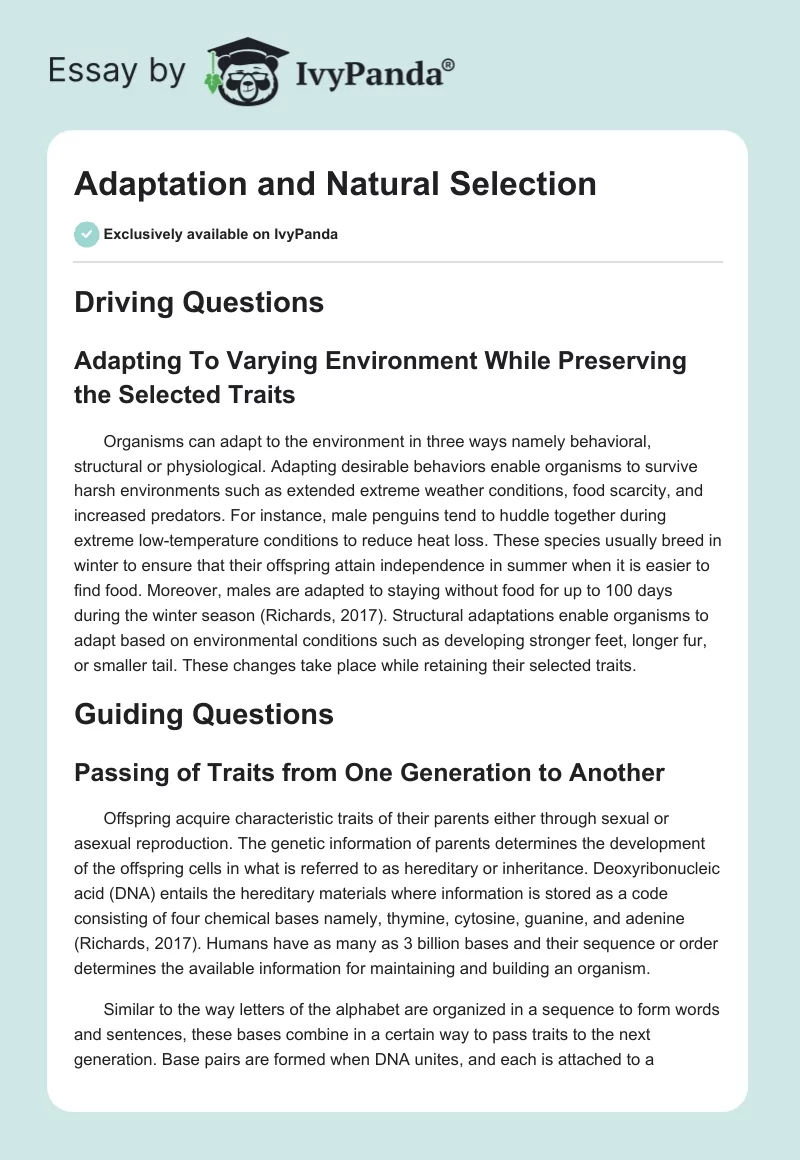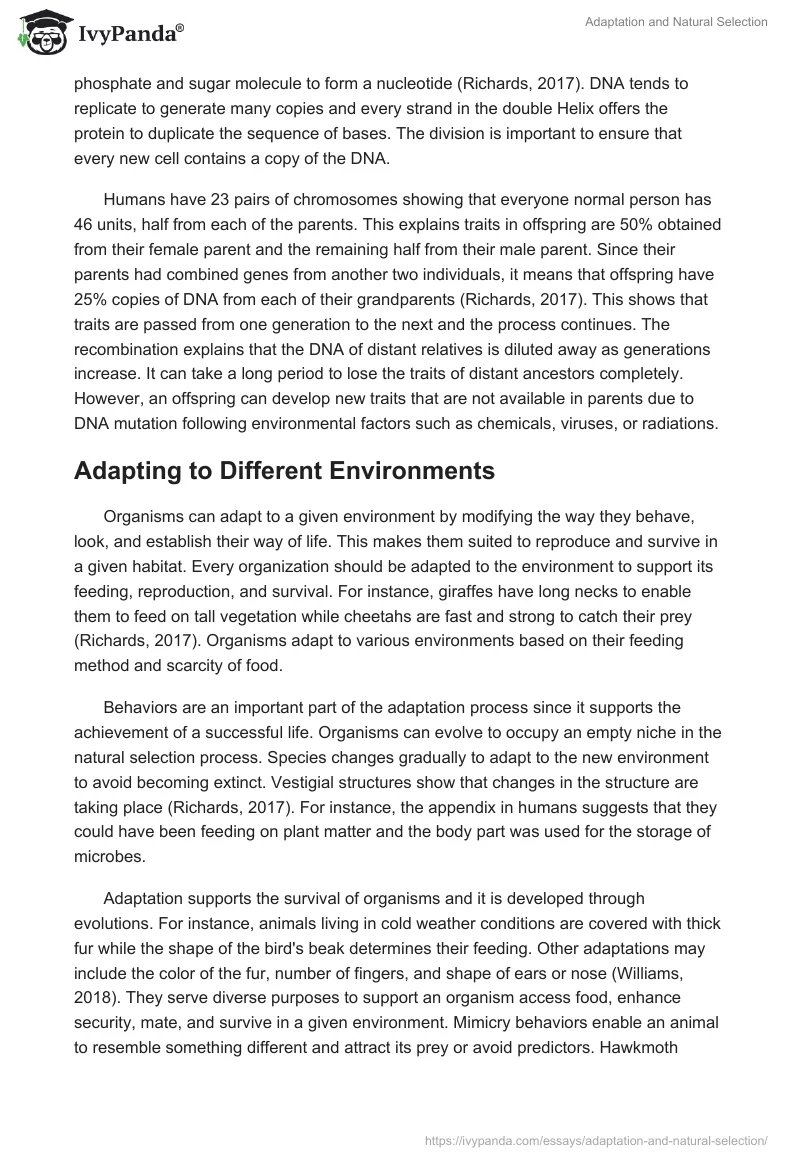Driving Questions
Adapting To Varying Environment While Preserving the Selected Traits
Organisms can adapt to the environment in three ways namely behavioral, structural or physiological. Adapting desirable behaviors enable organisms to survive harsh environments such as extended extreme weather conditions, food scarcity, and increased predators. For instance, male penguins tend to huddle together during extreme low-temperature conditions to reduce heat loss.
These species usually breed in winter to ensure that their offspring attain independence in summer when it is easier to find food. Moreover, males are adapted to staying without food for up to 100 days during the winter season (Richards, 2017). Structural adaptations enable organisms to adapt based on environmental conditions such as developing stronger feet, longer fur, or smaller tail. These changes take place while retaining their selected traits.
Guiding Questions
Passing of Traits from One Generation to Another
Offspring acquire characteristic traits of their parents either through sexual or asexual reproduction. The genetic information of parents determines the development of the offspring cells in what is referred to as hereditary or inheritance. Deoxyribonucleic acid (DNA) entails the hereditary materials where information is stored as a code consisting of four chemical bases namely, thymine, cytosine, guanine, and adenine (Richards, 2017). Humans have as many as 3 billion bases and their sequence or order determines the available information for maintaining and building an organism.
Similar to the way letters of the alphabet are organized in a sequence to form words and sentences, these bases combine in a certain way to pass traits to the next generation. Base pairs are formed when DNA unites, and each is attached to a phosphate and sugar molecule to form a nucleotide (Richards, 2017). DNA tends to replicate to generate many copies and every strand in the double Helix offers the protein to duplicate the sequence of bases. The division is important to ensure that every new cell contains a copy of the DNA.
Humans have 23 pairs of chromosomes showing that everyone normal person has 46 units, half from each of the parents. This explains traits in offspring are 50% obtained from their female parent and the remaining half from their male parent. Since their parents had combined genes from another two individuals, it means that offspring have 25% copies of DNA from each of their grandparents (Richards, 2017). This shows that traits are passed from one generation to the next and the process continues.
The recombination explains that the DNA of distant relatives is diluted away as generations increase. It can take a long period to lose the traits of distant ancestors completely. However, an offspring can develop new traits that are not available in parents due to DNA mutation following environmental factors such as chemicals, viruses, or radiations.
Adapting to Different Environments
Organisms can adapt to a given environment by modifying the way they behave, look, and establish their way of life. This makes them suited to reproduce and survive in a given habitat. Every organization should be adapted to the environment to support its feeding, reproduction, and survival. For instance, giraffes have long necks to enable them to feed on tall vegetation while cheetahs are fast and strong to catch their prey (Richards, 2017). Organisms adapt to various environments based on their feeding method and scarcity of food.
Behaviors are an important part of the adaptation process since it supports the achievement of a successful life. Organisms can evolve to occupy an empty niche in the natural selection process. Species changes gradually to adapt to the new environment to avoid becoming extinct. Vestigial structures show that changes in the structure are taking place (Richards, 2017). For instance, the appendix in humans suggests that they could have been feeding on plant matter and the body part was used for the storage of microbes.
Adaptation supports the survival of organisms and it is developed through evolutions. For instance, animals living in cold weather conditions are covered with thick fur while the shape of the bird’s beak determines their feeding. Other adaptations may include the color of the fur, number of fingers, and shape of ears or nose (Williams, 2018). They serve diverse purposes to support an organism access food, enhance security, mate, and survive in a given environment. Mimicry behaviors enable an animal to resemble something different and attract its prey or avoid predictors. Hawkmoth appears like a veined, tattered and deaf leaf to avoid being noticed easily by its predators.
Determining the Inherited Traits through the Punnett Square
The Punnett square involves a square diagram applied to determine or predict a genotype of a given breeding experiment. The approach enables biologists to calculate the probability of an offspring acquiring a particular genotype. It offers a tubular summary of expected combinations of alleles maternal. The created tables facilitate the examination of the probabilities of the genotypical outcome of the offspring for single or multiple traits. Inherited traits can be determined by drawing a grid entailing perpendicular lines (Williams, 2018). The next step involves inserting one parent’s genotype across the top of the table and the other parent down on the left. One letter for the parent is entered in each box on either side of the table. The next step involves filling boxes by copying the column and row head letters down or across into the squares. The process offers a predicted frequency for the potential genotypes in the case of reproduction.
The Natural Selection Process
Natural selection enables organisms to evolve and adapt through enhancing reproduction and survival. The best-adapted species tend to survive in a given environment as nature filters the poorly fitted populations. The process takes five basic steps namely, variation, selection, inheritance, time, and adaptation. Organisms in a given species tend to have varying traits such as the ability to fight off ailments, size, and coloration (Williams, 2018). These differences occur because of “copying error” or random mutations during the cell mutation. Offspring inherits the parents’ variation because traits are encoded in the DNA.
When the population overgrows and becomes unlimited, it becomes impossible to support it since resources become scarce. Organisms that are successful in mating, finding food, and avoiding predators are more likely to survive and reproduce. Variations determine the ability of species to survive and pass their DNA to the next generations (Williams, 2018). This means that subsequent generations will have certain beneficial traits for survival as the others die off. Desirable traits are passed on in greater numbers as certain traits continue to become uncommon in the population. A better-adapted and suited population are developed depending on the environmental conditions. Many changes can occur such as having modified legs to serve as wings to enhance the ability to survive in a given environment.
Reference
Richards, E. (2017). Darwin and the making of sexual selection. University of Chicago Press.
Williams, G. K. (2018). Adaptation and natural selection: A critique of some current evolutionary thought. Princeton University Press.


